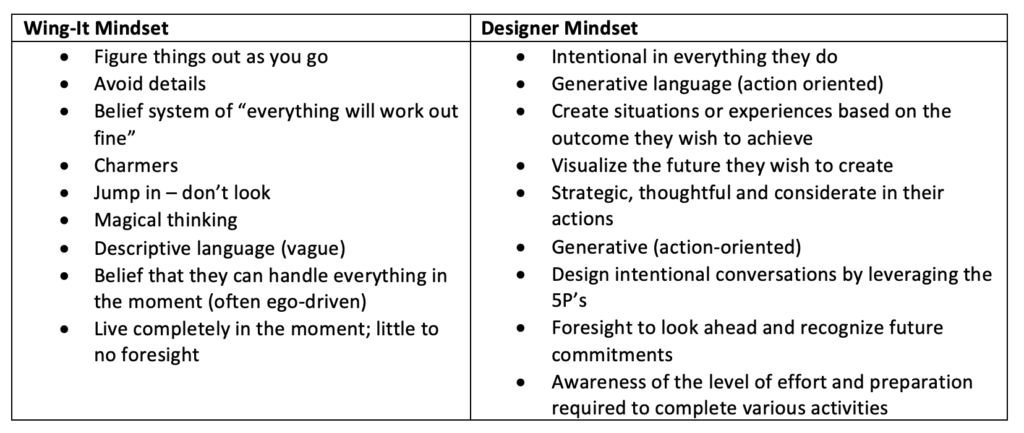What type of leader are you?
Are you a “Wing-It” or a “Designer” leader in your life?
What’s the difference?
- The “Wing-It’s” – The “Wing-It’s” get-by and survive with little to no preparation and hope for the best. A wing-it mindset is driven by the belief that they can handle a conversation without quality preparation and design. A “Wing-It” thinks and acts completely in the moment with outcomes that are not predictable or repeatable.
- The “Designers” – A “Designer” is intentional and creates (through generative language and actions) the outcomes they desire. “Designers” prepare, coordinate with others, and show up knowing the outcome they wish to achieve. Generally, desired outcomes are pre-determined, and actions are aligned to create the desired outcomes.
“Wing-It’s” are individuals, teams and organizations that want to grow their companies, improve performance, and achieve results, but get stuck due to a lack of intentional design in their conversations to move forward.
As a company grows, its demands, requirements, and needs change. Behaviors and ways of doing things that enabled the company to get by, survive, and just-make-it-happen in the past become incompatible with the future the company wants to create.
A “Wing-It” just wants to get it done, while a “Designer” wants it to be intentional, repeatable, and to provide the desired results.
As executive leadership coaches, we strive to move “Wing-It’s” to become “Designers”.
Moving from a “Wing-It” to a “Designer” mindset starts with your “Way of Being”.
When you choose to be intentional by being a designer of your conversations, then your actions and behaviors become intentional, and eventually, your words and actions become reflected in the outcomes, results, and performance that is produced on a consistent basis.
“Wing-It’s” Vs “Designers”

For most new business leaders, it is the wing-it mindset that starts the company and keeps the lights on, and then as time goes on and the needs of the company grow and develop, the company begins to need “Designers” who can create desired outcomes through intentional design.
“Designers,” think and act intentionally and strategically because they have a strong relationship to time which makes them reliable with their word. They create the plans that provide the focus needed to achieve KPI’s (key performance indicators) and can measure the effectiveness of the efforts.
Leadership Challenge:
What is one thing you are going to design, through intentional preparation, to create the outcome you desire over the next 7 days?








